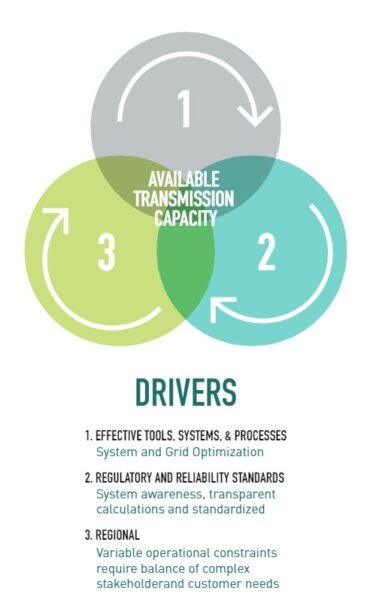Case Study
Available Transfer Capability Modernized
Opportunity
The region is experiencing large changes in its generation profile. such as coal and natural gas being retired, new variable wind and solar resources, causing new transmission and operational constraints. These constraints impact stakeholders and customers and must be communicated.
Regulatory and reliability standards require alignment in planning and operational studies and capability calculations, with increased granularity. Impacts on adjacent systems and native load must be understood.
Flexible systems, tools and processes provide the foundation for future enhancements. They must be in place for system and grid optimization, to provide greater transparency, to allow for quantitative analysis for policy decisions and to enhance response effectiveness for congestion events.
Aligning Across Functions
The utility initiated a program to enhance its methodology of providing short term Available Transfer Capability (ATC). Part of the program included a project to automate the power flow network solutions process. The purpose was to align activities, data stores, and processes for the transmission operations and transmission planning groups to feed data into the transmission sales and marketing groups for the purpose of posting ATC for public viewing.
The approach of the program was to manage the power flow case variations associated with the following activities:
- Partner coordination
- Seasonal planning cases
- Internal network construction planning cases
- Market and market participant activities planning cases
- Grid stability and operational planning cases
It also involved evaluating the Total Transmission Capacity (TTC), the Existing Transmission Commitment (ETC), and developing the Available Transfer Capacity (ATC) for the purpose of generating market order dispatch as well as the invocation of curtailment programs as needed. This process accounted for load forecasts, the merit order stack, transmission capacity, the network topology and outages, prior solved power flow studies, as well as the forecasts for variable generation output. The result provided the available transfer capacity on the transmission lines to feed power from the utility to various distribution interties within its own transmission area as well as external entities.

Multiple Data Exchanges
The approach developed a centralized storage capability based on the IEC CIM and the ENTSO-E standards. This centralized storage capability could be used to retrieve existing solved cases and update various components based on the completion of new construction, the presence of outages either within the utility controlled network or as conveyed by intertie organizations through the WECC cases, or even the source of generation to model congestion and the need for curtailment.
Xtensible worked to plan the data pull from numerous internal systems as well as the WECC data exchange portal. Data exchanges with the following systems were included:
- webTrans
- Open Access Same Time Information System (OASIS)
- tagDump
- Western Interchange Tool (WIT)
- ATC State Awareness Tool (ASAT)
- Capacity Reservation System
- Curtailment Manager
- System Control and Data Acquisition (SCADA)
- DARt
Result
The finalized solution produced the storage data model and defined data exchange formats which could be used by both transmission operations and transmission planning as well as a set of common starting cases. This allowed both organizations to start with the same assumptions when providing data to the transmission sales and marketing group to publish the correct Available Transfer Capacity values for public consumption.
“Defining the data exchange formats was crucial to accomplish seamless integration across systems, and ultimately to allow for public visibility and accuracy” says Harry Garton, VP of Professional Service at Extensible, and the project manager.
What Is Happening next
The utility continues its modernization initiatives. The portfolio includes projects designed to increase automation, improve accuracy, and enhance visibility into how the power and transmission systems are functioning in real time, to ultimately enhance the optimization and reliability of the grid
Technologies
|
Business Unit Involvement
|




